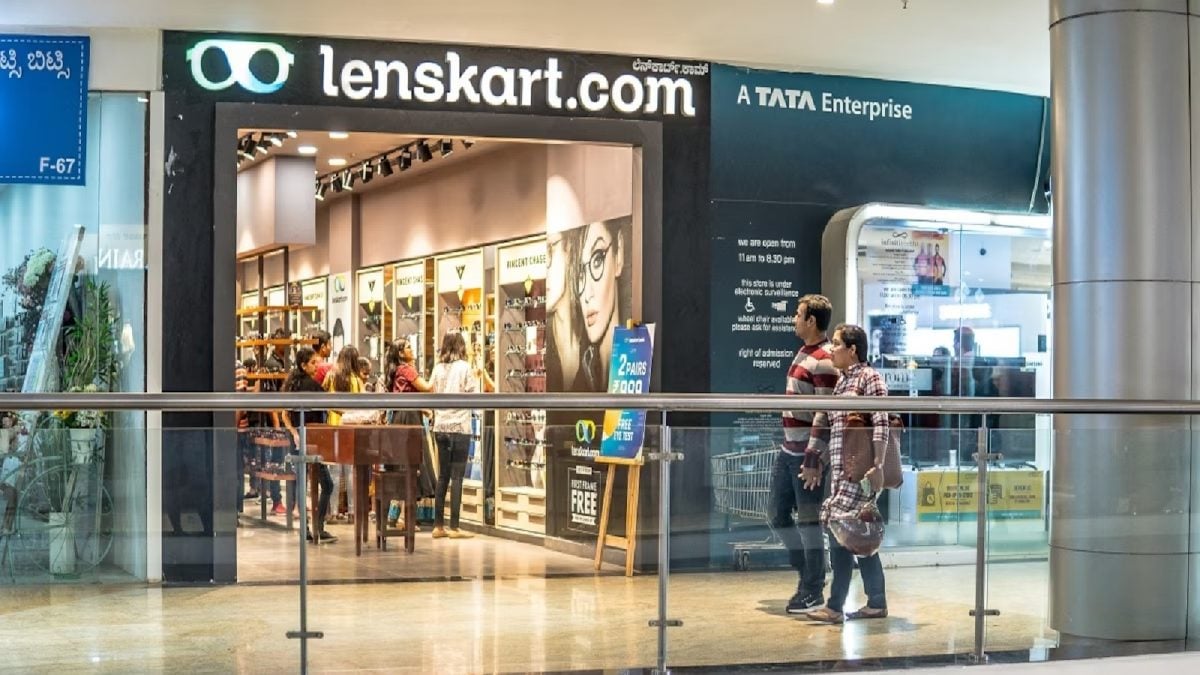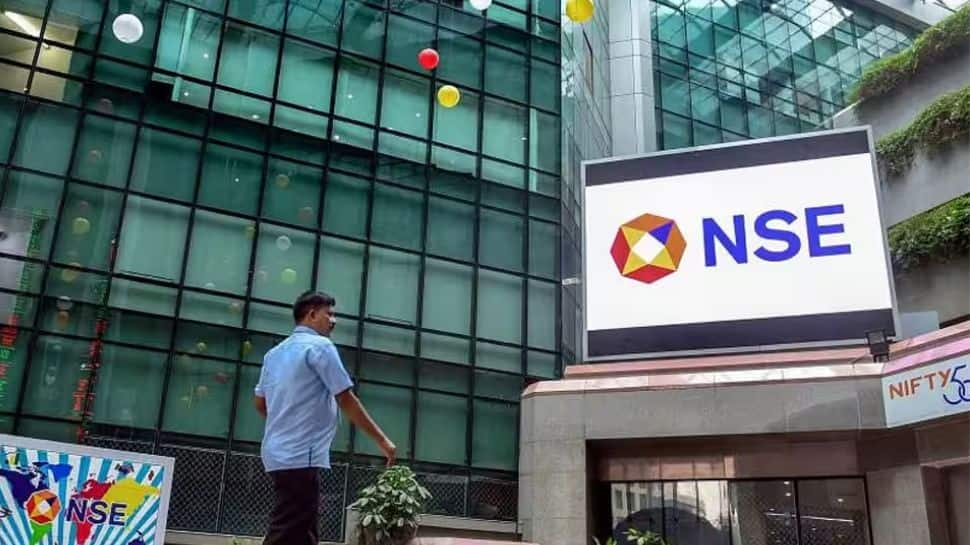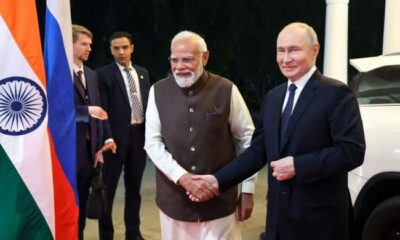Business
Lenskart IPO GMP Today Falls Amid Valuation Concerns: Know Opening Date, Price, Reviews

Last Updated:
Lenskart IPO GMP Today: The company’s grey market premium has slightly fallen to 16.5% on Wednesday, compared with over 18% on Tuesday and nearly 27% on Monday.
Lenskart IPO GMP Today.
Lenskart IPO GMP Today: Eyewear retailer Lenskart Solutions is set to launch its initial public offer (IPO) on Wednesday, October 31. The price band of the Rs 7,278-crore IPO has been fixed in the range of Rs 382-Rs 402 apiece. Analysts have raised valuation concerns with the IPO, which comes at a price-to-earnings (P/E) ratio of 230x. According to market observers, the grey market premium or GMP has slightly fallen to 16.5% on Wednesday, compared with over 18% on Tuesday and nearly 27% on Monday.
Lenskart IPO: Opening, Closing, Allotment, Listing Dates
The IPO will be opened on October 31 and closed on November 4. Its allotment will be finalised on November 6, while the stock listing is scheduled to take place on November 10 on both BSE and NSE.
Lenskart IPO GMP Today
According to market observers, unlisted shares of Lenskart Solutions Ltd are currently trading at Rs 468 apiece in the grey market, against the upper IPO price of Rs 402. It means a grey market premium (GMP) of 16.42%, indicating decent listing gains for investors.
The GMP is based on market sentiments and keeps changing. ‘Grey market premium’ indicates investors’ readiness to pay more than the issue price.
Lenskart IPO: What Analysts Say
Analysts point towards the high valuation of the company. SBI Securities said that at the upper end of the price band, Lenskart’s valuation stands at 10.1 times its FY25 EV/Sales and 68.7 times EV/EBITDA on a post-issue basis.
The analysts at SBI Securities cautioned that the issue appears stretched on valuation, which may cap potential listing gains. However, they highlighted the company’s strong business model and the significant growth opportunity in India’s expanding eyewear market as key positives.
The brokerage also noted that profitability metrics will need close monitoring as the company continues to scale its operations. Lenskart’s EBITDA margin has notably improved from 7% in FY23 to 14.7% in FY25, reflecting operational efficiency. Considering the company’s long-term prospects, SBI Securities has recommended subscribing to the IPO for the long term at the cut-off price.
Though the Lenskart Solutions IPO is debuting at a steep valuation of around 234 times its price-to-earnings (P/E) ratio, analysts said assessing the company’s valuation solely on the basis of its P/E ratio may not present a fair picture. They said Lenskart operates in a high-growth segment with significant untapped potential, given the low penetration of eyewear in India.
According to the Redseer Report, Lenskart emerged as the leading seller of prescription eyeglasses by volume in FY25 among organised retailers in India. The company has also expanded its footprint beyond domestic markets, establishing a presence in Japan, Southeast Asia, and the Middle East.
SBI MF Invests Rs 100 Crore In Lenskart
SBI Optimal Equity Fund (AIF) and SBI Emergent Fund (AIF), invested Rs 100 crore in eyewear retailer Lenskart Solutions Limited through a pre-IPO transaction at a transfer price of Rs 402 per equity share.
As part of the transaction, Neha Bansal, one of the promoters, who held 7.61% of Lenskart’s pre-offer paid-up equity share capital (fully diluted basis) prior to the transfer, transferred 2,487,561 equity shares. Neha Bansal continues to hold 7.46% of the pre-offer share capital of the Company on a fully diluted basis after the transfer. The share sale does not form part of the IPO Offer for Sale.
The investment comes on the eve of the opening of Lenskart’s Initial Public Offering (IPO) scheduled for Friday, October 31, 2025.
Last week, Billionaire investor Radhakishan Damani, founder of Avenue Supermarts (DMart), invested around Rs 90 crore in eyewear retailer Lenskart through a pre-IPO transaction, according to people familiar with the development.
Lenskart IPO Price Band and Size
The company has fixed the price band at Rs 382-402 per share for its IPO. At the upper end of the price band, Lenskart is seeking a valuation of around $7.91 billion (about Rs 72,700 crore).
The issue includes a fresh issue of shares worth Rs 2,150 crore, while the offer-for-sale (OFS) segment will see promoters and investors offloading more than 12.75 crore equity shares.
Key Selling Shareholders in the OFS
Along with founders and promoters (Peyush Bansal, Neha Bansal, Amit Chaudhary, and Sumeet Kapahi), several major investors are participating in the OFS. These include SoftBank’s SVF II Lightbulb (Cayman), Schroders Capital, PI Opportunities Fund, MacRitchie Investments, Kedaara Capital Fund, and Alpha Wave Ventures.
Notably, Schroders Capital Private Equity Asia (Mauritius) is set to make a complete exit, selling 1.9 crore shares, which represent a 1.13% stake in the company.
About Lenskart
Founded in 2010, Lenskart began as an online eyewear retailer and has since grown into one of India’s leading omnichannel eyewear brands with both online and offline presence. The company was valued at $6.1 billion as of September 2025, according to Tracxn data cited by Reuters.
In June 2025, the company transitioned into a public limited entity — changing its name from Lenskart Solutions Private Limited to Lenskart Solutions Limited after an extraordinary general meeting held on May 30.
Lenskart IPO Lead Managers and Objective
The fresh issue will be used for business expansion, new investments, acquisitions and general corporate purposes.
The IPO will be managed by a consortium of top investment bankers, while the registrar and book-running lead managers will be responsible for allotment and investor coordination.
With strong brand visibility, a robust online-offline model, and solid investor backing, the Lenskart IPO is expected to generate significant interest among both retail and institutional investors.

Haris is Deputy News Editor (Business) at news18.com. He writes on various issues related to personal finance, markets, economy and companies. Having over a decade of experience in financial journalism, Haris h…Read More
Haris is Deputy News Editor (Business) at news18.com. He writes on various issues related to personal finance, markets, economy and companies. Having over a decade of experience in financial journalism, Haris h… Read More
October 29, 2025, 12:14 IST
Read More
Business
Gold, Silver Prices Jump Sharply This Week; Yellow Metal Surges By Rs 4,000

New Delhi: Gold and silver prices witnessed a sharp surge in the domestic market this week, tracking strong gains in global bullion markets. Gold prices rose by around Rs 4,000 per 10 grams, while silver prices jumped by nearly Rs 17,000 per kilogram. According to data from the India Bullion and Jewellers Association (IBJA), the price of 24-karat gold increased by Rs 4,188 to Rs 1,32,710 per 10 grams, compared to Rs 1,28,592 a week ago.
The price of 22-karat gold climbed to Rs 1,21,562 per 10 grams from Rs 1,17,777, while 18-karat gold rose to Rs 99,533 per 10 grams from Rs 96,444. Silver prices outperformed gold, registering a sharper weekly rise. The price of silver surged by Rs 16,970 to Rs 1,95,180 per kilogram, up from Rs 1,78,210 per kilogram a week earlier.
Earlier on Friday, Silver touched the Rs 2 lakh mark to hit an all-time high of Rs 2,013,88 per kilogram on the Multi-Commodity Exchange (MCX) during the intraday trade. The price of the future contract expiring on March 5, 2026, rose over Rs 2,400 during the day before settling at Rs 2,00462, up Rs 1,520 against the previous session’s closing of Rs 1,98,942.
“Gold and silver ETFs have been quiet heroes of the year, delivering standout returns even as equity markets saw bouts of volatility. Silver, especially, stole the spotlight — a rare combination of booming industrial demand from solar, EVs and electronics, alongside tightening global supply, pushed prices sharply higher,” said Nikunj Saraf, CEO, Choice Wealth.
Gold too held its ground and climbed steadily, supported by persistent central-bank buying and investors seeking safety amid geopolitical and inflation worries, he added. The gold future contract expiring on February 5 surged 1.87 per cent to close at Rs 1,34,948 per 10 grams on MCX on Friday. In the retail market, the 24-carat gold price settled at Rs 132,710 per 10 grams, up over Rs 4,600 from the previous day’s closing of Rs 1,28,596 per 10 grams, according to the IBJA.
The rally in domestic bullion prices is largely driven by continued strength in international markets, with both precious metals hovering close to their all-time highs. On the COMEX, gold was trading at $4,328 per ounce, while silver stood at $62 per ounce.
Business
Nifty 50, Nifty Midcap 150 Emerge As Top Indices In November: Report

New Delhi: Nifty 50 and Nifty Midcap 150 emerged as best-performing indices in November, with a growth of 1.87 per cent and 1.59 per cent, respectively, a report said on Saturday. Meanwhile, Nifty 50 outperformed with a return of 7.27 per cent, 5.87 per cent, and 8.59 per cent over the last 3 months, 6 months, and 1-year period, respectively.
At the same time, the Nifty Midcap 150 continued to show steady traction with gains of 7.93 per cent, 6.01 per cent, and 7.12 per cent across the same 3-month, 6-month, and 1-year periods, Motilal Oswal Mutual Fund said in its report.
The broader market also delivered healthy gains, with the Nifty 500 gaining 0.94 per cent in the previous month, with large and midcap stocks up about 1-2 per cent and smallcaps corrected by around 1-3 per cent. Over the last 3 months, 6 months, and 1 year, the index has consecutively given positive returns of 6.55 per cent, 4.96 per cent and 5.94 per cent, the report noted.
The Nifty Smallcap 250 Index showed mixed momentum, declining 3.36 per cent during the month, while recording a moderate 1.37 per cent gain over the past 3 months. However, returns remained subdued over longer periods, with the index slipping 0.60 per cent over 6 months and 5.55 per cent over the 1-year horizon.
The Nifty Microcap 250 Index also reflected volatility, registering a 2.83 per cent decline in November. According to the report, the Nifty Next 50 Index ended the month with a marginal decline of 0.98 per cent but maintained positive momentum over the medium term with gains of 5.16 over 3 months and 3.56 per cent over 6 months, while delivering −2.25 per cent over the 1 year.
Sector performance remained mixed with IT delivering an increase of 4.74 per cent, Auto 3.60 per cent, Banks 3.42 per cent and Healthcare 2.30 per cent in November. The Defence sector delivered the strongest annual performance with an impressive 19.43 per cent return, emerging as the best-performing segment over the year.
The Auto sector followed closely at 18.85 per cent, the Banking sector also posted a healthy 14.79 per cent gain, and Metals also recorded a strong 13.94 per cent. Healthcare generated 6.40 per cent, indicating steady but moderate expansion.
Realty, on the other hand, slipped further by 4.69 per cent in November and 11.47 per cent in the past year. The broader trend shows a 1–4 per cent decline across these segments during November, reflecting sector-specific pressures and profit-taking after earlier rallies, the report highlighted.
Business
Maruti Suzuki To Launch 4 New Cars In 2026, Including 2 EVs And Brezza Facelift; Check Details

Maruti Suzuki is preparing to expand its product lineup in India in 2026 with the launch of four new models. After introducing only one new car in 2025—the Victoris—the automobile company plans to add two electric vehicles, a flex-fuel model, and a refreshed version of the Brezza compact SUV next year.
In 2026, Maruti Suzuki will strengthen its portfolio by entering new segments and updating existing models. The planned launches include the e Vitara electric SUV, a flex-fuel version of the Fronx, an all-electric MPV codenamed YMC, and a facelifted Brezza.
Maruti Suzuki e Vitara
The Maruti Suzuki e Vitara is expected to be launched in January 2026. The e Vitara is expected to be offered with two battery options—49kWh and 61kWh—both paired with a front-mounted electric motor. Maruti Suzuki has claimed a driving range of up to 543 km. The electric SUV has also received a 5-star safety rating under the Bharat NCAP crash test programme.
This electric midsize SUV will compete with models such as the Mahindra BE 6, Hyundai Creta Electric, MG ZS EV, VinFast VF6, and Tata Curvv EV.
Fronx Flex Fuel
Maruti Suzuki will introduce its first flex-fuel engine in the second half of 2026. This engine will debut in the Fronx compact SUV. The flex-fuel powertrain is expected to support ethanol-petrol blends of up to E85, which consists of 85 per cent ethanol and 15 per cent petrol.
Apart from the new engine, the Fronx Flex Fuel is expected to remain unchanged in terms of design and features when compared to the current petrol version.
Electric MPV Codenamed ‘YMC’
The company’s second electric vehicle for 2026 will be an all-electric MPV, codenamed YMC. It is scheduled to be launched towards the end of the year. The YMC will be based on the same platform as the e Vitara but will feature an MPV body style.
The YMC is likely to use the same 49kWh and 61kWh battery packs as the e Vitara, with an expected range of around 500–550 km.
Brezza Facelift
Maruti Suzuki is also preparing a facelift for the Brezza compact SUV, which is expected to arrive around mid-2026. Spy images suggest minor design updates, along with possible interior changes and additional features. The Brezza facelift is expected to come with the 1.5-litre petrol engine producing 103hp, along with manual, automatic, and CNG options.
-

 Politics6 days ago
Politics6 days agoThailand launches air strikes against Cambodian military: army
-

 Sports1 week ago
Sports1 week agoAustralia take control of second Ashes Test | The Express Tribune
-

 Fashion6 days ago
Fashion6 days agoGermany’s LuxExperience appoints Francis Belin as new CEO of Mytheresa
-

 Politics6 days ago
Politics6 days agoZelenskiy says Ukraine’s peace talks with US constructive but not easy
-

 Politics7 days ago
Politics7 days ago17 found dead in migrant vessel off Crete: coastguard
-

 Tech1 week ago
Tech1 week agoWIRED Roundup: DOGE Isn’t Dead, Facebook Dating Is Real, and Amazon’s AI Ambitions
-

 Business1 week ago
Business1 week agoNetflix to buy Warner Bros. film and streaming assets in $72 billion deal
-

 Politics1 week ago
Politics1 week agoIndia and Russia set for major trade discussions today






